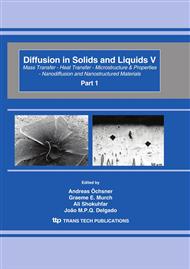p.875
p.881
p.887
p.893
p.899
p.906
p.912
p.918
p.924
Electroless Ni-P Composites with ZrO2: Preparation, Characterization, Thermal Treatment
Abstract:
The study of composite electroless Ni-P coatings is pursued in order to obtain coatings on a metal substrate with advanced properties i.e. with high wear and corrosion resistance for particular engineering uses. Composite NiP-ZrO2 layers were prepared by simultaneous electroless co-deposition of Ni-P and ZrO2 on steel, from a reducing solution in which ZrO2 particles were kept in suspension by stirring. The particles load in the bath was 0, 0.5, 1.0, 2.0 and 5.0 g/l. The deposits of 30 m in thickness, were characterized for structure, morphology and hardness by scanning electron microscopy and microanalysis as well as X-ray diffraction. It was found that the maximum ZrO2 particle incorporation attained was 7-10% of Zr. Vickers microhardness was measured for the plain deposit and found to be 720 HV and for the maximum zirconia content of 10%, 820 HV. After a vacuum heat treatment for 10 min, the microhardness of the composite is found to be 1500 HV. The electrochemical linear polarization measurements in a corrosive NaCl 3.5% solution shows at 2.0 g/l bath load favourable conditions for the formation of a defects free composite deposit could be created.
Info:
Periodical:
Pages:
899-905
Citation:
Online since:
April 2010
Authors:
Price:
Сopyright:
© 2010 Trans Tech Publications Ltd. All Rights Reserved
Share:
Citation:


